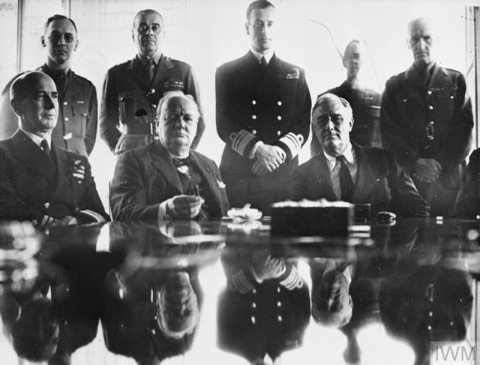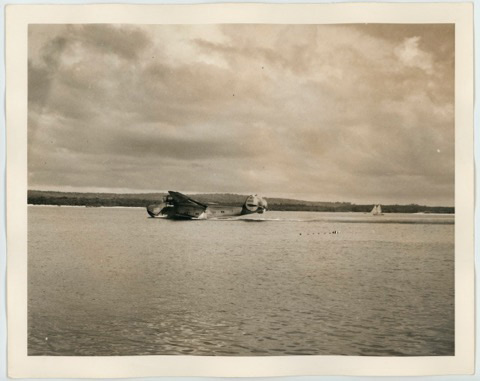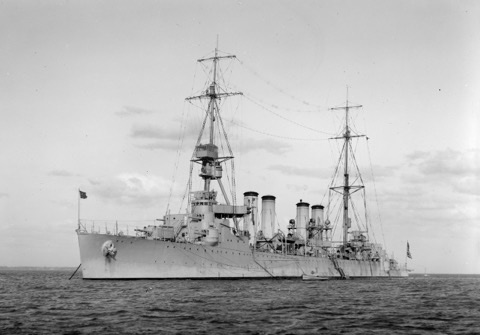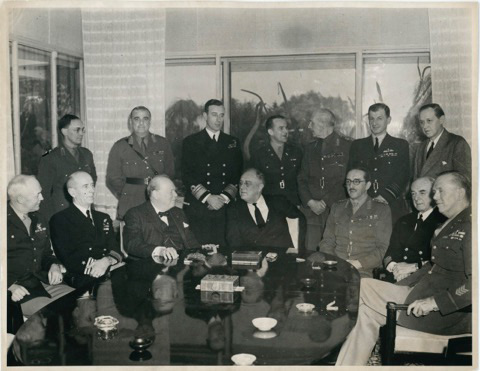Artículo The National Archive, 10.01.2017 Paul M. Sparrow, director
In January, 1943, President Roosevelt embarked on a secret mission that would determine the course of World War Two, and ultimately the world we live in today. His destination – Casablanca, Morocco. His goal – to finalize Allied military plans with the British Prime Minister, Winston Churchill. It was a precedent shattering odyssey. No president had ever left the United States during wartime, or ever visited Africa, or even ever traveled in an airplane. No president since Lincoln had visited an active battlefield. And FDR did all of those things without the press finding out.
The Allies had landed in North Africa just two months earlier, and after a series of bloody setbacks had Germany’s Field Marshall Erwin Rommel – the Desert Fox – on the run. The looming question was – what to do next? The conference would force top military leaders of Great Britain and the United States to hash out their differences and agree on a strategy for victory.

Mr Churchill with President Roosevelt and Chiefs of Staff at one of the many important meetings held at the Villa. Copyright: © IWM. Original
Although hundreds of pages of detailed plans and contingencies were written during the Casablanca Conference, two words stand out as perhaps the most significant of any uttered during the entire war. Two words that defined President Roosevelt’s pledge that “…the American people in their righteous might will win through to absolute victory.” Two words that would set an almost impossible target for the greatest military force the world has ever known – “Unconditional Surrender.”
President Roosevelt’s journey began on January 9th in Washington, D.C. when he boarded his special train and headed north. Because of wartime security it was not unusual for the President’s travel plans to remain classified, and the press assumed he was headed to his home in Hyde Park, New York. In Baltimore he secretly changed direction and headed south for Miami. In all of his previous voyages across the Atlantic FDR had traveled by his favorite means of transportation – ship. But the dark waters of the Atlantic had turned into a killing zone, a deadly hide-and-seek between German submarines and Allied transports. Hundreds of cargo ships and thousands of sailors had been lost to torpedoes in the preceding months as Nazi submarine “wolf packs” prowled the seas. Their mission was to strangle Great Britain by cutting off the vital supplies those cargo ships carried. Even traveling by battleship was considered too dangerous for the President. The only “safe” means of travel to Africa was by plane. So in Miami he boarded a Pan American seaplane, the Dixie Clipper, and at 6:30 am FDR became the first president to fly while in office.
The route was convoluted and dangerous. The first stop was Port au Spain, Trinidad, a ten hour flight from Miami. FDR and his closest advisors spent the night at the Macqueripe Hotel and took off at 5:30 am the next morning.

One of two Boeing Clippers (“Dixie Clipper”) which carried the Presidential Party from Miami, FL, to North Africa (Casablanca Conference)
Nine hours later they landed on the Para River near Belem, Brazil. After a brief stop and refueling, they began the most dangerous leg of the journey – 2100 miles over the Atlantic Ocean. Any mechanical failure over the open ocean would be a deadly disaster. Strong head winds and turbulence forced the pilots to fly low, between 1,000 and 3,000 feet. After a grueling 19 hours they finally saw the African coast, and at 4:45 pm on January 13 they arrived at the mouth of the Gambia River in British controlled Gambia.

State Library of Victoria
The USS Memphis was anchored and waiting for the Commander in Chief. The President insisted on seeing the local area, and boarded a small motorboat. The nearby community of Bathurst was a “squalid and disease ridden town” according to one of the officers who accompanied FDR. The terrible living conditions of the native population reinforced Roosevelt’s strong belief that the age of Imperialism had to come to an end.
The Presidential party dined aboard the USS Memphis and the next morning boarded two C-54 transport planes for the final 1,600 miles to Morocco. They flew over Dakar, the Senegal River, across the Sahara Desert and over the legendary Atlas Mountains. They finally landed in Casablanca at 5:00pm on January 14th.
Casablanca was well within the range of German bombers, so secrecy was a top priority. Lt. Colonel Elliot Roosevelt met his father when he arrived, but even he had not been told why he was going to Morocco. The presidential party made its way to the Anfa Hotel where the conference would take place. The guest book reveals the names of some of the attendees: Winston Churchill, Franklin Roosevelt, Gen George Patton, FDR’s closest advisor Harry Hopkins and many others.
That evening the British and American leaders had dinner, and FDR and Churchill stayed up until 3am discussing strategy, drinking and smoking like long lost friends. The villa FDR was staying in was called “Dar Es Saada” which Churchill translated as “Abode of Divine Favor.”
The meetings began the next morning, January 15th. While there were many areas of discussion, the main topic was the “second front.” Although the Soviet leader Joseph Stalin was not there, he had made it very clear that he was furious the Allies had not opened a second front in Europe. The Red Army was suffering tremendous casualties as they fought to defend Moscow, Stalingrad and Leningrad from a ferocious German assault. Nearly four million German troops and thousands of tanks were deep within Russia and Stalin was insistent that the British and Americans launch a cross channel invasion to draw off some of the Nazi war machine that was devouring Russia. While the tide was starting to turn in Stalin’s favor, an estimated 10 million Russians had already died.

FDR and Churchill at a conference with the Joint Chiefs of Staff during the Casablanca Conference.
The British and American military leaders had been at odds for more than a year about when they should invade France. The British had convinced the American’s to attack North Africa first, and they now wanted to invade Sicily and take control of the Mediterranean. Some of the Americans wanted to focus on the war in the Pacific against the Japanese. The German submarine attacks had made it very difficult to supply Britain and the Soviet Union with all of the supplies they needed. Now that the war in Africa was moving toward a conclusion, it was essential that the Allies develop a clear plan for victory.
The meetings went on for ten days, and tempers flared on more than one occasion. Adding to the complexity was the role of the French, who had initially fought the Americans when they came ashore in Morocco. There were two French factions, one led by General Henri Giraud, and one by General Charles De Gaulle. One British general noted that they hated each other more than they hated the Germans.
This was the first time since the Civil War that an American president had been in a battle zone and FDR was determined to review the troops, despite the objections of the Secret Service. The battle of Morocco had ended just two months earlier, and hundreds of thousands of American troops were now coming ashore and heading into battle in Tunisia. But none of them knew their Commander in Chief was in their midst.
On January 18th President Roosevelt reviewed the 30th Infantry Battalion near Casablanca, and on the 21st he traveled up the coast to Rabat, where some of the fiercest fighting had taken place, to review the 3rd Infantry Division. The GIs were “shocked and thrilled” to see FDR as he saluted from his jeep. The president visited the new military cemetery at Mehdia, and had lunch with Harry Hopkins, Gen. Patton and his troops. FDR ate standard army rations from a mess kit: boiled ham, sweet potatoes, string beans and coffee.
The Army band played his favorite songs, including “Chattanooga Choo Choo” and “Deep in the Heart of Texas.” Roosevelt was deeply moved by the experience and when he returned home he wrote dozens of personal letters to the families of servicemen he met and to the families of the soldiers buried at Mehdia.
On January 22, the Sultan of Morocco and the 13 year old crown prince hosted FDR and Churchill for dinner. It was an opulent affair, with the traditional exchange of state gifts. In this case a jewel encrusted tiara and a magnificent ceremonial sword.
Finally on January 24th the conference came to an end. About 40 British and American war correspondents were flown in from Algiers and Tunisia. They were not told why they were going, and were stunned to find out that the President, the Prime Minister and their combined Chiefs of Staffs and military leaders had been in North Africa for more than a week. FDR demonstrated once again his genius in using the media to tell the story he wanted told.

FDR – with Winston Churchill at Casablanca, seated on lawn
It was a beautiful day, the Moroccan skies a deep clear blue as the North African sun blazed brightly overhead. Security was extremely tight, the area was surrounded with barbed wire and armed guards every 20 feet. Fighter planes circled overhead. Roosevelt and Churchill invited the reporters to sit on the grass and then they read their statements and took questions.
One of the first things that FDR said was that Premier Stalin had been invited to join them, but he could not come because of the battles raging in Russia. It was during this press conference that FDR first publicly brought up “unconditional surrender” of Germany, Italy and Japan. That phrase generated enormous discussion and controversy. There are still those who say that it startled Prime Minister Churchill (including Wikipedia) because he had not expected FDR to use those words. That is simply not true. The idea of “unconditional surrender” had first come up with American military leaders in May, 1942, and Churchill himself had used the phrase in a telex to his war cabinet and had approved its use in the press release which was drafted on January 18th.
What might have startled Churchill, and led to later confusion, is FDR’s inclusion of Italy because Churchill had argued that they should leave the door open for a separate peace treaty with Italy. The manner in which FDR said it might also have surprised Churchill as it was a departure from the approved statement. After saying rather formally that “peace can come to the world only by the total elimination of German and Japanese war power” FDR lapsed into his folksy storytelling mode. “Some of you Britishers know the old story — we had a General called U.S. Grant. His name was Ulysses Simpson Grant but in my, and the Prime Minister’s, early days he was called “Unconditional Surrender” Grant. The elimination of German, Japanese and Italian war power means the unconditional surrender by Germany, Italy and Japan.”
Prime Minister Churchill reiterated the President’s statements, describing the ten day meetings as “the most important and successful war conference which I have ever attended or witnessed.” He called himself FDR’s “active and ardent Lieutenant” and described the great success the Allies were having in North Africa. He called Field Marshall Rommel “the fugitive of Egypt and Libya” and described the British 8th Army’s pursuit of him this way: “I can give you this assurance – everywhere that Mary went the lamb is sure to go.” The press roared with laughter.
Although they played only a minor role in the military discussions, the political crisis of the two opposing French leaders was also eased by FDR’s media savvy. After FDR, Churchill, De Gaulle and Giraud posed for photographs, FDR suggested the two leaders shake hands for the camera. Although De Gaulle at first refused, he did eventually agree. A photograph of the two French leaders shaking hands was a coup for FDR, though it did little to resolve the animosity between them.
The conference ended with high hopes and great expectations. But Churchill had one last request for the president – accompany him to Marrakesh, “simply the nicest place on Earth to spend an afternoon.” At 1:30 pm on the 24th a well-armed caravan left Casablanca and headed south for the walled city of Marrakesh. FDR and Churchill drove past camel caravans, olive and orange groves, and arrived at a Villa being used by the American Vice Consul. The villa’s surroundings were described as a “garden from a Maxfield Parish painting.”
Churchill told the villa’s servants to form a chair with their arms and carry President Roosevelt up to the top of the villa’s small tower. They two great leaders watched the peaks of the Atlas Mountains turn pink as the sun set over the Moroccan desert.
The next day FDR started his return voyage home, and Winston Churchill came to the airfield to say his good-byes dressed in bedroom slippers and a silk robe. The President’s entourage stopped at Gambia, Liberia, and Brazil finally arriving in Trinidad on January 29th. The news had finally broken about the Casablanca Conference, and huge crowds turned out to see the President when he arrived in Port au Spain. President Roosevelt flew the final leg to Miami on his 61st birthday, and enjoyed birthday cake with his closest advisors.
He boarded his private train in Miami and was back at the White House by 6:30 pm on January 31st.
The Casablanca Conference was a smashing success, and it inspired the world with its boldness and audacity. There were still many months of bitter fighting ahead, but in every way, the tide was turning in the Allies favor. Even FDR’s most stalwart opponents conceded his success. The Republican newspaper editor William Allen White wrote, “…we are compelled to admit that Franklin Roosevelt is the most unaccountable and on the whole the most enemy-baffling President that this United States has ever seen… a certain vast impudent courage… Well damn your smiling old picture, here it is… We, who hate your gaudy guts, salute you.”


